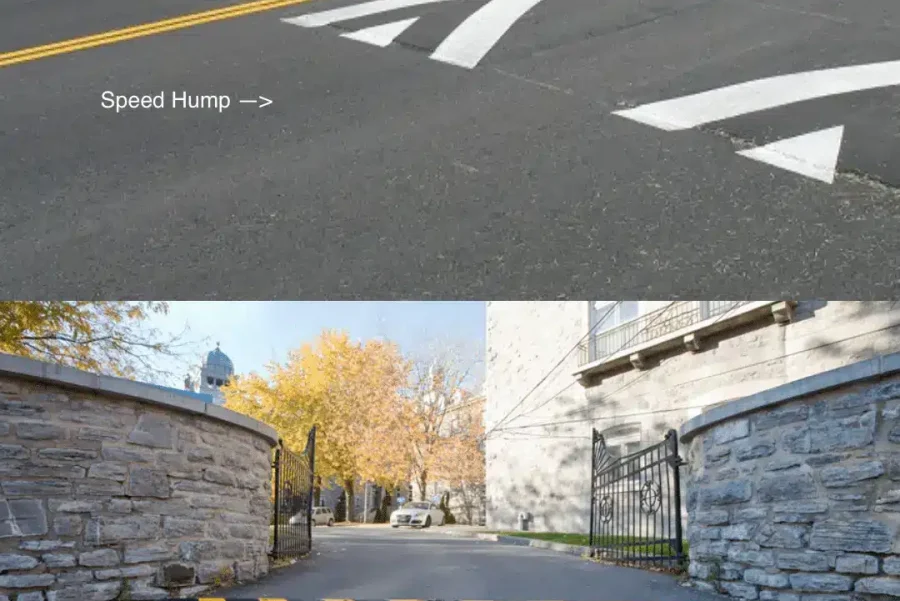Car accidents are a common fear for many people because of how frequently they occur and the potential for damage, financial burden, injuries, and, in the most unfortunate possibilities, loss of life. Collisions involving pedestrians are particularly concerning. Governments worldwide have implemented various efforts to reduce pedestrian-involved accidents, including speed tables, feedback signs, and traffic circles. One of the most popular options for improving pedestrian safety in residential neighborhoods is the use of speed humps.
KEY TAKEAWAYS
- Speed humps are common and practical traffic-calming measures designed to reduce the likelihood of vehicle-pedestrian collisions.
- Speed humps are different from speed bumps in both their design and purpose.
- Studies indicate that speed humps can reduce vehicle speeds down by approximately ten mph on average, which can significantly lower pedestrian injury as a result.
- Buffalo’s Slow Streets program allows city residents to apply for speed hump installation online.
- Clusters of speed humps can feel inconvenient for drivers at times, but they are a positive and effective investment for municipalities.
What Is A Speed Hump?
Of course, we all know what speed humps are, right? Actually, many people are not entirely up to speed (no pun intended) on how these traffic-calming structures work. Contrary to popular belief, speed humps are not the same as speed bumps. A speed hump, as defined by the Department of Transportation (DOT), is a “rounded, raised area placed across the roadway, typically 12 to 14 feet long.” Their design and placement create a continuous speed reduction. In contrast, a speed bump is shorter but higher in height and more abrupt than its counterpart. Bumps are placed mainly in areas like parking lots or driveways, where the intention is to bring traffic to a more significant speed reduction or a near stop.
Speed humps are usually installed in batches on residential neighborhood streets; the repetition of raised areas forces vehicles to maintain a safe speed. The idea is that it controls pedestrian safety without the need for human interference (e.g., police patrols at the corner of an intersection that sees high rates of speeding or collisions).
While a police sighting might prompt most drivers to slow down, speed humps present another element: an absolute consequence. A driver may not see a cop car or a pedestrian, or they may ignore the “reduced speed” sign, but if a driver fails to notice or chooses to ignore a speed hump, you will likely damage your car. This factor is why placing these raised structures is believed to improve safety significantly.
The Numbers
Many people question whether speed humps actually produce the intended result and if placing them on residential blocks is the best way to calm traffic. However, studies have shown speed humps are indeed effective in many ways. In 2014, the DOT summarized dozens of traffic studies, highlighting the most valuable information regarding speed humps and other traffic calming measures. The results show that, on average, speed humps reduce vehicle speed by 20-25% or roughly ten mph.
For a more straightforward example, the American Journal of Public Health completed a matched case study specifically targeting the influence speed humps have on the number of collisions involving children. The study was conducted in Oakland, California, over five years. Researchers found that “speed humps were associated with a 53% to 60% reduction in the odds of injury or death among children struck by an automobile in their neighborhood.”
Furthermore, Reid Ewing, the Director of the Metropolitan Research Center at the University of Utah and author of the “U.S. Traffic Calming Manual,” found speed humps to be the leader out of the most common traffic calming measures. When directly compared to the others, speed humps accounted for the most significant difference in average reported speed after installation.
Speed Bumps in the City of Buffalo
If you’re reading this from the Queen City and are sold on the idea of speed humps on your street, we’ll point you in the right direction. In response to an uptick in speedy traffic reports, the city of Buffalo formed the Slow Streets program. The system allows seamless communications between Buffalo homeowners and the city’s Department of Public Works (DPW) regarding speed hump installation. A pilot version of the program was rolled out in 2019 and has been operating smoothly ever since. Many city residents appreciate this option over the short-lived speed cameras that auto-generated tickets only in school zone areas.
The process to get these elevated asphalt structures is pretty straightforward. However, you will need to present a majority vote from others in your area, as individual requests are not considered. Instead, the DPW requires those interested in speed hump installation to apply alongside others and form a “neighborhood zone.” The city defines a zone as “a small network of low volume, mostly residential streets.”
1. Submit an application here. Only one application is necessary per neighborhood zone (which you are asked to map out yourself). You can check to see if someone has already created a zone that includes your residence here.
2. The application is reviewed by the DPW, Buffalo Fire, and the NFTA to ensure the speed humps do not conflict with their routes. The neighborhood point person listed on the application will be notified upon review, and the map linked above will be updated to reflect any decisions or changes.
3. After review, surveys are mailed out to every address within the applying neighborhood zone. A QR code prompts the homeowners to vote. 75% of votes in favor of speed hump installation will initiate the next step.
4. Residents in the approved neighborhood zone will receive additional notification advising where the speed humps will be placed along the streets and when construction is expected to begin.
Throughout the above process, DPW allows residents to communicate with them about the details of their neighborhood zone application. The time it takes for DPW to send a contractor to begin installation depends on weather conditions and funding availability. Snowy conditions might delay the installation process, but something of particular concern for Buffalo residents is speed humps’ impact on plowing. Speed humps are designed to allow for plow trucks to pass through. Therefore, in contrast to speed bumps, speed humps remain throughout our intense winter season and should not affect plowing and alternate parking zones.
Conclusion
Speed humps are a cost-effective and efficient way for cities to invest in their residential neighborhoods by prioritizing pedestrian safety. Cities with established systems, like the Slow Streets program, allow residents to have a say in their community.
We have seen a lot of promising changes happening in Buffalo’s downtown and residential neighborhoods. The implementation of speed humps, bike lanes, and the restructuring of main roads have all contributed to improving general safety and traffic efficiency. Altering something we utilize daily, like our streets, can feel frustrating and sometimes unnecessary. Understanding the reasoning behind these changes (like suddenly encountering a handful of speed humps on your way to work) helps residents appreciate our local governments’ efforts. In turn, it goes a long way in promoting continued growth for Buffalo.
Richmond Vona is a New York Personal Injury law firm with offices in Buffalo, Niagara Falls, and Rochester, dedicated to fighting for those injured due to the negligence of others. For more information, please visit richmondvona.com or call us at 716-600-HURT

